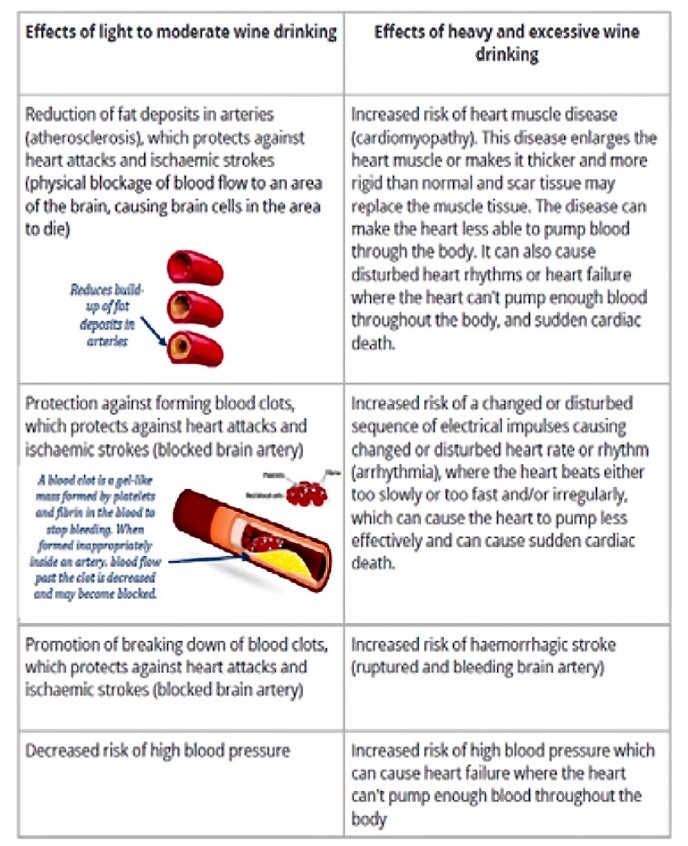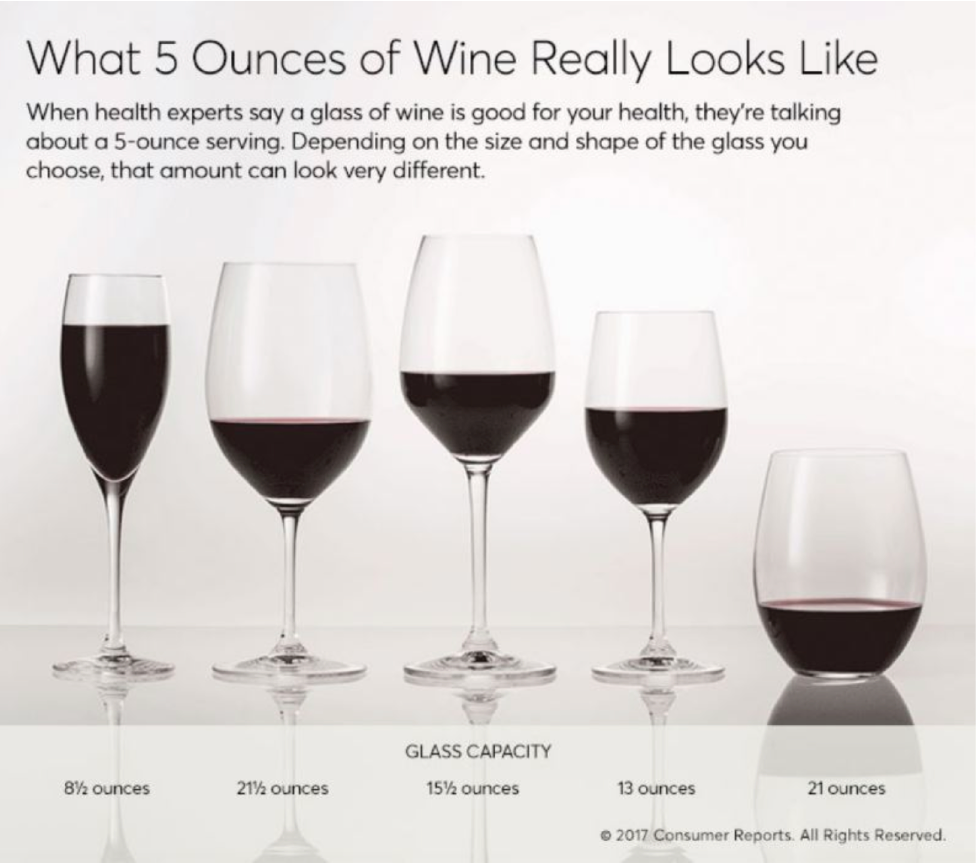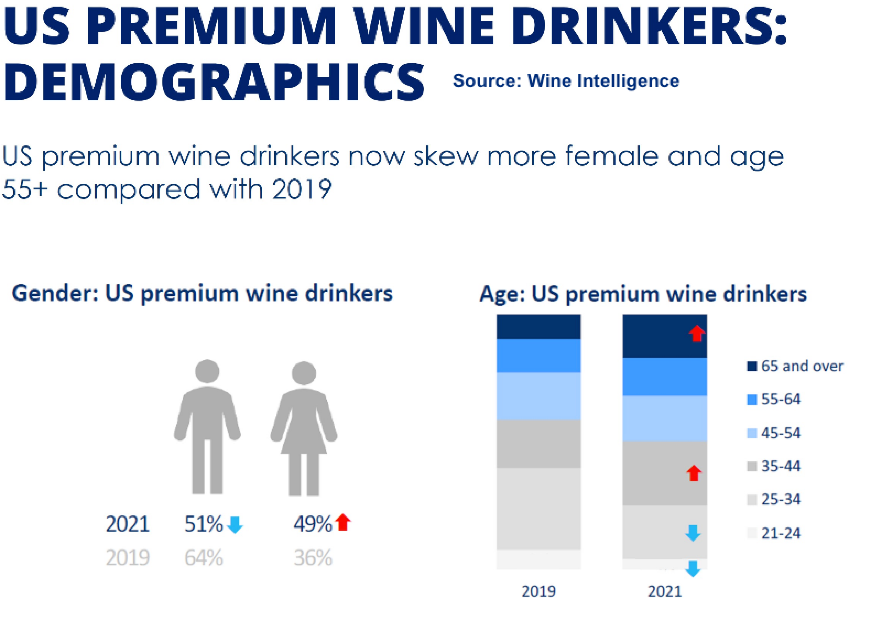PinotFile: 12.25 December 13, 2021
|
Debating the Health Benefits of Wine: An Update
I read all of the medical literature and research on the relationship between alcohol beverages and healthy, yet I find it challenging to decipher the differing reports. The uncertainty stems primarily from the fact that all human research to date has been with cohort and case-control studies. There have been no well-executed, randomized, double-blinded, intervention trials controlled for all confounding variables. Still, although well-performed observational studies cannot completely exclude possible genetic or environmental predilections to health outcomes, criteria do exist that can establish a very high probability of causality in these data. I last wrote about the debate as to the health benefits of wine in Volume 11, Issue 40 of the PinotFile: www.princeofpinot.com/article/2162/. This issue offers an update on studies published and the opinions of health care experts in the almost three-year interval.
*Dr. Stockley’s review of key cohort studies found a reduced risk of cardiovascular disease and high blood pressure by about 30%, reduced risk of ischemic stroke by about 20% and a decrease in high and unbalanced cholesterol by about 10%, with the consumption of 1-2 drinks per day of alcohol compared with lifelong abstainers.

*Alcohol achieves its effect in a number of ways with polyphenols giving additional protection. The removal and transporting LDL cholesterol from the vessel walls may account for 50% of the benefit.

*The benefits are only associated with moderate consumption and higher levels of drinking are associated with higher blood pressure, atrial fibrillation and hemorrhagic stroke, for example. Dr Skovenborg looked at the importance of the pattern of drinking and its effect on the J shaped curve. The J shaped curve has withstood the test of time after years of critique and correction of methodological flaws. However, the importance of effect-modifying factors like drinking patterns and elements of lifestyle has become increasingly clear during the last decade. His findings:
*Those who drink little and often have better disease and longevity outcomes than those who abstain or drink heavily. A large Danish study found that for the same average consumption of alcohol, a nonfrequent intake implied a higher risk of death than a frequent intake. *Eating while drinking significantly reduces blood alcohol concentration of alcohol and is a much healthier pattern of drinking than drinking without eating. Binge drinking is particularly harmful. A large Danish study found that for the same average consumption of alcohol, a non-frequent intake implied a higher risk of death than a frequent intake. Dr Skovenborg went on to look at the effects of alcohol on cancer risk.
*There is no question that alcohol is associated with some cancers, notably breast and cancers of the upper digestive tract. Alcohol is estimated to be linked to 3.3% of cancers. Breast cancer risk can be somewhat mitigated by adequate folate in the diet. The combination of smoking and drinking is particularly carcinogenic for cancers of the upper digestive tract. *In terms of the risk of dying overall (all-cause mortality) than the five heart-healthy lifestyle factors are crucial leading to a 65% lower cancer mortality, for example. Professor Ellison emphasized the importance of all-cause mortality and the significance of the pattern of drinking and adhering to other healthy lifestyle behaviors.
*Do we live longer if we enjoy a glass of an alcoholic beverage on a near-daily basis? The answer, for healthy post-menopausal women and men over 40 is still very much, ‘yes’. *Current scientific data indicate that adults who consume alcohol regularly, with food, and without binge drinking, have a lower risk of most of the diseases of aging and tend to live longer than if they consumed no alcohol.

* The J shaped curve is relevant to late-onset diabetes with a significantly reduced risk among moderate drinkers are shown in study after study. A large recent study supports the role of a good diet that includes wine in heart health:
*The ASPirin in Reducing Events in the Elderly (ASPREE) clinical study published in the European Journal of Preventive Cardiology focused on the lifestyle and health of healthy American and Australian adults over the age of 70. The study did not include former drinkers who may have stopped consuming alcohol for health reasons. Study participants who consumed 3.5 to 7 drinks per week were less likely to suffer cardiovascular events than those who abstained. Those who consumed moderate amounts of alcohol had lower rates of overall mortality compared to heavier drinkers. The study results only support a correlation and not causation but add more evidence supporting the health benefits of moderate consumption of alcoholic beverages. European politicians have recently come out in support of the health benefits of moderate drinking
*The Comté Eurpéen des Entreprises Vins (CEEV) that represents the wine trade in the European Union (EU), is urging the European Parliament to reconsider the statement that there is “no safe level of alcohol consumption”, which came from an EU report in the Special Committee on Beating Cancer (BECA), a claim that was based on a flawed study. Despite the opposition, the EU report was adopted by the European Parliament. CEEV notes that the ‘no safe level’ message is counterproductive, as the moderate consumption of wine, particularly as part of the Mediterranean diet and as part of a healthy lifestyle, is associated with greater longevity and the prevention of disease. The ‘no safe level’ assumption is based on a single study - Global Burden of Diseases (GBD) study published by The Lancet in 2018 which has been severely criticized by the scientific community for its analytical flaws. Seminar supports wine drinking in moderation:
*The results of a study called PREDIMED (Prevención con Dieta Mediterránea) looked at wine and weight management was presented at a seminar earlier this year. Glucose tolerance and triglycerides levels were measured among the 7,500 randomized participants. The results indicated that wine drinkers, particularly those having between 7 and 14 units per week, had a lower number of cardiovascular risk factors compared to non-drinkers.
 The 2021 American Heart Association Dietary Guidance to Improve Cardiovascular Health was published in the November 2, 2021, issue of Circulation. Evidence-based dietary pattern guidance to promote cardiometabolic health includes the following: (1) maintain healthy body weight; (2) eat plenty and a variety of fruits and vegetables; (3) choose whole-grain foods and products; (4) choose healthy sources of protein (mostly plants, regular intake of fish and seafood, low-fat or fat-free dairy products, and lean cuts and unprocessed forms of meat and poultry; (5) use liquid plant oils rather than tropical oils and partially hydrogenated fats; (6) choose minimally processed foods instead of ultra-processed foods; (7) minimize the intake of beverages and foods with added sugars; (8) choose and prepare foods with little or no salt; (9) if you do not drink alcohol, do not start; and (10) If you choose to drink alcohol, limit intake.
 Elaborating more on alcohol consumption, the Dietary Guidance noted that the relationship between alcohol intake and cardiovascular disease is complex. The risk appears to differ by amount and pattern of alcohol intake, age and sex of individuals and type of cardiovascular outcome. As alcohol intake increases, so does the risk of hemorrhagic stroke and atrial fibrillation. For coronary heart disease and ischemic stroke, there is a J shaped relationship, with the lowest risk at low alcohol intake. (1 to 2 drinks per day and higher risks at no intake and higher intake). The 2020 Dietary Guidelines Advisory Committee recently concluded that those who do drink should consume no more than 1 drink per day and should not drink alcohol in binges. In contrast, the 2020-2025 Dietary Guidelines for Americans continues to recommend no more than 1 drink per day for women and 2 drinks per day for men.
Drinking Wine in ModerationIn understanding the relationship between wine consumption and health, it is important to realize the definition of “moderate drinking.” In the United States, a standard drink (or unit) is defined as containing 17.7 ml of ethanol which is about 14 grams of pure alcohol equivalent to 12 ounces of about 5% beer, 5 ounces of about 12% alcohol table wine, and a shot of 80-proof about 40% alcohol distilled spirits. A full bottle of wine (750 ml) contains 5 to 7 drinks depending on the alcohol percentage or ABV. To determine the number of standard drinks in a bottle of wine, multiple 750 ml by the alcohol percentage and divide by 17.7.A bottle of 16% alcohol wine will have about 1 more drink than a bottle of 13% alcohol wine, the point being that alcohol percentage (ABV) does make a difference when you are looking to drink in moderation. One would want to scale back the volume of drinking when imbibing a wine with a higher alcohol percentage. Many wine drinkers do not understand the concept of a standard drink and this leads to a false sense of drinking within the confines of moderation. Understandably, this is challenging since wine tastes so damn good. It’s like restricting sex to moderation. Here is what a standard drink or 5 ounces of wine looks like depending on the type and size of wine glass chosen:
 A global view of the percentage of regular wine drinkers who are or are not moderating their alcohol intake shows that about one-third of USA wine drinkers are actively moderating their consumption:
 Remember that any health benefits to be derived from alcohol in moderation are only achievable through regular consumption preferably with meals. Drinking wine with a meal increases cardioprotective benefits, aids digestion (the pH of wine is close to that of stomach acid), decreases food-borne pathogens and may help diabetics metabolize sugars and starches. It is often advised that wine consumers consult their physician about their alcohol consumption habits. The caveat there is that in my experience most physicians are lacking in knowledge about the relationship of wine and health so keep wine consumption moderate to be safe and possibly beneficial.
Holdredge Wines: Small Production with High Quality
The small but inviting winery is located in an old red barn on Front Road in Healdsburg. The barn dates to the late 1800s when it was a winery owned by the French-American Tartar Works and initially run by Georges de la Tour. He departed from the French-American Tartar Works in 1900, purchased four acres of land in Rutherford that became the foundation for Beaulieu Vineyard. The property then passed onto the Scatena Brothers Wine Company who moved to Grove Street in Healdsburg and was ultimately purchased by the Seghesio family. During Prohibition, the building was a fruit packing and cannery house. After Prohibition, it became the home of Prima Vista Winery, producing half-million gallons a year of mostly sweet wine. In the late 1930s, Prima Vista was sold to the huge Roma Wine Company, the largest of its time. Roma evacuated the barn in the early 1960s and it became home to many other types of businesses. The Holdredges arrived in 2001, made a few improvements but John says, “Things are pretty much the same as they ever were.” John points out that the historical connection is evident in the secondary fermentation that all occur naturally without any intervention due to a very active strain of lactic acid bacteria living in the barn left over from one of the past wineries. John is a self-taught winemaker aided by friends. When the winery was launched in 2001, he and Carri planned to work with Zinfandel and Syrah. When winegrower Sara Lee Knude offered to sell John some Pinot Noir and now John works with fourteen different Pinot Noir vineyards and makes no Zinfandel or Syrah. Carri leaves the winemaking to John, but with a superior palate, she is instrumental in giving the final approval to every Pinot Noir. She focuses on sales and the management of the winery.
 John summarizes his winemaking as follows: “To make Pinot is to always remember that Mother Nature is in charge and the only way to even begin to unravel the mysteries of the grape are to supplicate to her each year.” He avoids addition to his wines and fermentations are always native (wild). Grapes are typically destemmed followed by a long cold soak pushed out to 7-10 days. Only the “free-run” juice from pressing is bottled. Only barrels from one cooper are used to allow for a singular flavor profile. The percentage of new oak is limited. Bottling proceeds within a year when the wines are never fined and only filtered when absolutely necessary. Holdredge Pinot Noir labels are reminiscent of the album cover for “Layla” by Derek and the Dominoes with a woman’s face, a glass of red wine and maybe the side profile of a handsome man with a large nose. Noted artist, Carri’s father Tom O’Loughlin, provided the picture on the label. The tasting room room is open by appointment. Look for the giant oak Adirondack styled chair out front built from an oak tree located adjacent the winery that fell down. Undoubtedly it is the largest Adirondack chair in the US. Visit www.holdredge.com. Total production is 2,000 cases of Pinot Noir. Holdredge has been making wine from Rochioli Vineyard since 2012 and the wines have been of high quality consistently each year. A sampling of Holdredge Pinot Noir wines are reviewed below.
2018 Holdredge Rochioli Vineyard Russian River Valley Pinot Noir 14.4% alc., $70. · Moderately dark garnet color in the glass. Admirable purity of Bing cherry perfume with a hint of dark red rose petal and dark chocolate. Bold, yet discreet in a mid-weight plus style gifting a hearty charge of black cherry and cola flavor. Some, but not intrusive tannin is evident providing harmonious support to the rich fruit load. The extraordinarily long and generous finish seems to last an eternity. Built to age shown by the wine's excellence when re-tasted from an open bottle the following day. No mistaking the allure of Rochioli fruit which provided me with an early and and unusually gratuitous Xmas gift. Score: 95
 2019 Holdredge Rochioli Vineyard Russian River Valley Pinot Noir 14.4% alc.,124 cases, $70. Grapes are from a block off Sweetwater Springs Road known as the Sweetwater Block planted to Rochioli Vineyard West Block cuttings. · Moderate garnet color in the glass. The nose offers a Bing cherry jubilee that is pervasive. Perfectly balanced in a middleweight style with a satisfying core of black cherry, cola and spice flavors. Silken in texture with fully immersed oak and a persistent finish that leaves one fully satiated and reaching for another sip. Not quite the intensity of fruit and length of finish as the 2018 version of this wine, but still special in its own right. Score: 94
2018 Holdredge Three Sisters Vineyard Fort Ross-Seaview Pinot Noir 14.5% alc., 120 cases, $70. The vineyard sits at the top of the second ridge in from the Pacific Ocean at about 1,260 feet elevation. Located on Bohan-Dillon Road along with a handful of iconic Sonoma Cost vineyards including Marcassin, Seaview and Blue Slide. Soils are Josephine series residue of sedimentary and igneous rocks underlain with slate and shale. The grower is Lee Martinelli, Jr. and his wife Pam. · Moderate garnet color in the glass. Aromas of earthkissed black cherry, a hint of blackberry, spice and juniper. Light to mid-weight in style, offering a core of black cherry flavor with an underlying savory riff of tobacco and dried herbs. Refined and silky, with quenching acidity. Score: 92
Pinot BriefsFiddlestix Vineyard Sold The co-owner of the 94-acre Fiddlestix Vineyard for over two decades, Kathy Joseph has sold her vineyard to Justin Willett (Tyler Wines), Erik Mallea and Todd Gray (Willett-Mallea Farming) and William Borgers. The property was purchased in 1996, planted exclusively to Pinot Noir in 1998, and farmed by Kathy, Fiddlestix Vineyard, located in the Sta. Rita Hills AVA is one of the most esteemed Pinot Noir vineyard sites in Santa Barbara County. Known affectionately as the “Head Fiddle,” Kathy now plans to focus solely on working with other growers by expanding her reach to make small-lot wines from new regions and sites at her Fiddlehead Cellars winery. Currently, Fiddlehead Cellars produces about 4,000 cases annually of Grüner Veltliner (more recently planted at Fiddlestix Vineyard), Sauvignon Blanc and Pinot Noir at her winery in Lompoc, CA. In July of 2018, Kathy celebrated the 30th anniversary of Fiddlehead Cellars. Pictured are Kathy and her spouse and co-owner of Fiddlestix Vineyard, Tom Doyle at the 30th-anniversary event (see www.princeofpinot.com/article/2099/).
 Chateau St. Jean Sold to Foley Family Wines Foley Family Wines has acquired Chateau St. Jean from Treasury Wine Estates. Founded in 1973 in Sonoma Valley, Chateau St. Jean is known as a pioneer in the production of single-vineyard Chardonnay wines from Sonoma County, as well as for its flagship Bordeaux blend, Cinq Cépages. Read About Pinot Noir Master Ed Kurtzman With a resume that includes Bernardus, Chalone, Testarossa, Fort Ross, ROAR, Freeman, Mansfield-Dunne, August West and Sandler Wines, Ed is one of California’s most esteemed Pinot Noir winemakers. Access the conversation with Ed at www.thewinewrite.com. Read more about Ed in the PinotFile at www.princeofpinot.com/article/1200/. Vint Offers New Way to Invest in Wine This new investment platform assembles a collection of wines and individual investors buy shares in it for as little as $10 a share. Vint cellars the wines for several years and then sells the collection, distributing the returns to the investors. Vint hopes that the shares will increase in value as the wines become more valuable. The founders studied the data and found that wine has returned about 8.5% annually over the past 125 years. Each offering to investors is supported by a SECqualified circular. Visit www.vint.co. The Demographics of Premium Wine Drinkers
 Cooper Mountain Vineyards Expands in the Willamette Valley This family-run Oregon winery has acquired both Chehalem Mountain Vineyard and ArborBrook Vineyard and tasting room. Cooper Mountain Vineyards, founded by Dr Robert Gross and his wife Corrine Gross, is the first certified biodynamic winery in the Pacific Northwest. The winery is now run by their daughter, Barbara Gross. Since its founding in 1978, Cooper Mountain vineyards has acquired a reputation for producing organic and biodynamic wines including Pinot Noir. The expansion will result in ownership of 325 acres of land with 200 acres planted to vines and 125 acres to remain natural forest. Cooper Mountain Vineyards will begin converting Chehalem Mountain Vineyard and ArborBrook’s vineyard to organic and biodynamic in 2022. Chehalem Mountain Vineyard was the third vineyard planted in the Willamette Valley in 1969 by Oregon wine pioneer Dick Erath.
Holiday Wishes

Pinot Noir: Better Results Than Mistletoe: Happy Holidays! |